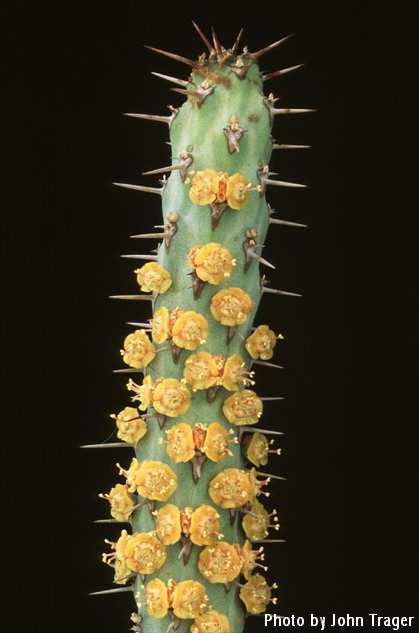East Africa is home to the richest diversity of spiny euphorbias, but Arabia also has its share. E. triaculeata is native to both areas. It bears paired stipular spines at the base of a central spine to half an inch long. In this form the spines are arranged in seven to eight spirals. The bright yellow inflorescences are small but quite showy when produced in abundance on the newer growth. Rooted cuts of HBG 39358, a plant collected Dec., 1977, by Lavranos (15904) & Newton, 5 km. S of Heys, Yemen. $7.50.
People who have experienced contact with the milky sap of euphorbias report a variety of unpleasant symptoms. On the skin it can result in blisters if not quickly dealt with. Even the vapors can result in stinging eyes and mucous membranes of the nasal passage, and sap in the eyes can cause temporary (or long-lasting) blindness. What all collectors of euphorbias should know—and what most medical professionals and poison control centers do not—is that the sap is not water-soluble but is fat-soluble. We have found the most effective method for cleaning it from skin or tools is to first rub it off with a vegetable- or mineral-oil-soaked towel, then to wash away the oil with soap and water. Insufficient research has been done to find lipid solvents that do not harm the eyes. Folk medicine claims that the juice of Aeonium lindleyi is an antidote for euphorbia sap, but no one has volunteered their eyes for a controlled experiment to prove its worth. When taking cuttings it is advisable to wear protective gloves, clothing and eyewear. If working for a prolonged period when the vapors are likely to be inhaled, a respirator fitted with organic chemical filters will prevent respiratory irritation.

Published in the Cactus and Succulent Journal, Vol. 75 (2), March - April, 2003